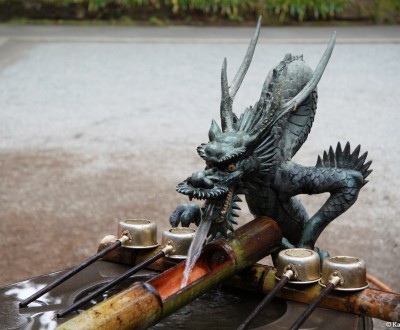Shinto worship
Diverse Shintoist pratices of daily life
Shintoism is often cited as a religion, and yet, before Japan welcomed Buddhism, locals did not talk about it as a proper religion, but rather as what might be called a philosophy of life. We can discover Shinto across rituals which punctuate the Japanese society, celebrations for specific ages or seasons of the year. They can be noticed in deeply anchored practices in daily life to the point that they can become nearly invisible.
From a specifically Japanese way of life to a religion
Just like many other animist cults, it is complicated to state when it started. The belief that all Earth elements have a spirit, that ancestors should be respected (by an effigy) and worshiping higher entities allowed Shintoism to last throughout ages. These spirits and entities are called kami, a term that is simplified in its translation by "gods" although the concept is more complicated. Indeed, Shintoism assumes that Humans and Earth are neutral. If an unfortunate event happens or if a man gets sick, especially in a period where nor science nor medicine existed, it was considered caused by a malicious spirit, therefore we had to ask for its pardon and purify the places.
It is only after the arrival of Buddhism in Japan, and the tumultuous history of these two cults, that Japan decided to put an end to the word religion: 宗教 shukyo. This term appeared during the 19th century to name other religions, period when Shinto became the State cult. More than a century later, this "religion" still reigns in the country, sitting next to Buddhism, the two of them mutually influencing each other. And yet its history was turbulent: the American army, during WWII, tried to destroy Shinto as this cult explained, according to them, the will of Japanese people to die for their country.
Shinto practices
Shinto is a positive religion celebrating life and family, therefore weddings happen during a Shinto ceremony. Buddhism takes care of funerals; in Shintoism, funerary ceremonies are very simple: The deceased person becomes an ancestor and an altar is dedicated to him in the family house, where members offer prayers and offerings. This altar is called 神棚 kamidana and is usually oriented towards the East or the South, where it will receive more light. We can easily make the difference between a Shinto altar and a Buddhist one as the first is higher and ornamented with a paper garland called gohei, while the latter possesses doors. The kamidana is also dedicated to worshipping a home god.
Shintoism does not have weekly rites such as Sundays mass for Christians, but rather annual celebrations and punctual rites done on demand. Among festivals, rituals and gestures, we can think of:
- Dosojin matsuri: fire festival held on January 15th, following the new year where decorations used on December 31st are burned in bonfires. The goal is to appeal luck for the coming year and to predict if the year will be fruitful or less lucky.
- Cleaning hands and mouth: (手水役 temizuya), when we enter a shrine or when we want to start praying. This gesture acts one of the main Shinto principles: cleanliness. We can encounter other gestures of this sort, for example removing shoes before entering in a house or a temple, or taking a shower before bathing.
- Love of nature: another great principle that we can find for example in Spring during hanami. It is traditional to block a day in order to be present very early and to be able to settle, for then picnicking and drinking under the trees. There is no real religious aspect to this celebration, which is more a social rite rather than a mystical one.
- Marriages and births which are only celebrated in Shinto and are practices of another founding principle: family. The family is the foundation of the society, it is the first community where the child belongs, the one towards which it has obligations and most of all, it is the holder of traditional knowledge. For these reasons, ancestors worshipping in Shinto is extremely important.
- And finally, the kami that have an essential place in Shinto daily life. There are neutral but can become benevolent or malicious if they feel worshiped or trampled. They represent what is pure and this idea plays a big role in the Japanese way of thinking, and in everyday life. Respecting all things comes from this principle and, as said before, any object can have its kami.
Obviously, the subject is only discussed on the surface here. In few words, Shintoism represents the Japanese spirit in its simplest form, being in this country for more than two millennia.

